- GCN/BACODINE POSITION NOTICE
TITLE: GCN/SWIFT NOTICE
NOTICE_DATE: Mon 06 Feb 06 04:47:08 UT
NOTICE_TYPE: Swift-BAT GRB Position
TRIGGER_NUM: 180455, Seg_Num: 0
GRB_RA: 202.946d {+13h 31m 47s} (J2000),
203.015d {+13h 32m 04s} (current),
202.381d {+13h 29m 31s} (1950)
GRB_DEC: +35.075d {+35d 04' 29"} (J2000),
+35.043d {+35d 02' 36"} (current),
+35.332d {+35d 19' 53"} (1950)
GRB_ERROR: 3.00 [arcmin radius, statistical only]
GRB_INTEN: 2718 [cnts] Image_Peak=199 [image_cnts]
TRIGGER_DUR: 0.512 [sec]
TRIGGER_INDEX: 124 E_range: 25-100 keV
BKG_INTEN: 27750 [cnts]
BKG_TIME: 17199.00 SOD {04:46:39.00} UT
BKG_DUR: 8 [sec]
GRB_DATE: 13772 TJD; 37 DOY; 06/02/06
GRB_TIME: 17213.27 SOD {04:46:53.27} UT
GRB_PHI: 135.41 [deg]
GRB_THETA: 10.56 [deg]
SOLN_STATUS: 0x3
RATE_SIGNIF: 21.61 [sigma]
IMAGE_SIGNIF: 10.17 [sigma]
MERIT_PARAMS: +1 +0 +0 +0 +2 +18 +0 +0 +51 +1
SUN_POSTN: 319.70d {+21h 18m 48s} -15.66d {-15d 39' 48"}
SUN_DIST: 120.60 [deg] Sun_angle= 7.8 [hr] (West of Sun)
MOON_POSTN: 55.27d {+03h 41m 04s} +23.80d {+23d 47' 42"}
MOON_DIST: 113.69 [deg]
MOON_ILLUM: 60 [%]
GAL_COORDS: 78.07, 78.28 [deg] galactic lon,lat of the burst (or transient)
ECL_COORDS: 184.87, 40.85 [deg] ecliptic lon,lat of the burst (or transient)
COMMENTS: SWIFT-BAT GRB Coordinates.
COMMENTS: This is a rate trigger.
COMMENTS: A point_source was found.
COMMENTS: This does not match any source in the on-board catalog.
COMMENTS: This does not match any source in the ground catalog.
COMMENTS: This is a GRB.
COMMENTS: This trigger occurred at longitude,latitude = 306.25,4.41 [deg].
- red DSS finding chart
ps-file
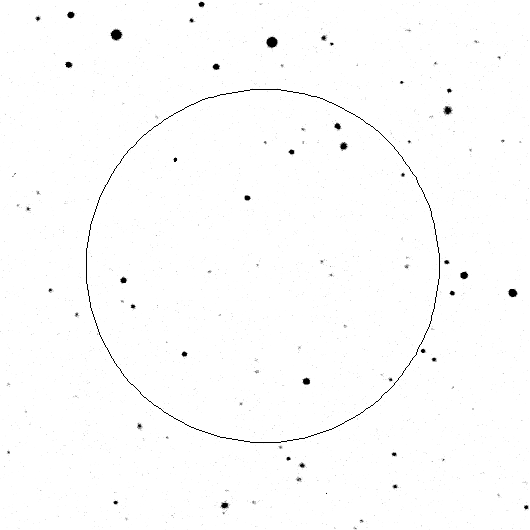
- GCN NOTICE
TITLE: GCN/SWIFT NOTICE
NOTICE_DATE: Mon 06 Feb 06 04:47:59 UT
NOTICE_TYPE: Swift-XRT Nack-Position
TRIGGER_NUM: 180455, Seg_Num: 0
POINT_RA: 202.961d {+13h 31m 51s} (J2000)
POINT_DEC: +35.073d {+35d 04' 22"} (J2000)
IMG_START_DATE: 13772 TJD; 37 DOY; 06/02/06
IMG_START_TIME: 17271.62 SOD {04:47:51.62} UT, 58.3 [sec] since BAT Trigger Time
COUNTS: 5 Min_needed= 20
STD_DEV: 0.00 Max_StdDev_for_Good=28.44 [arcsec]
PH2_ITER: 1 Max_iter_allowed= 4
ERROR_CODE: 1
COMMENTS: SWIFT-XRT Nack Position.
COMMENTS: No source found in the image.
- GCN NOTICE
TITLE: GCN/SWIFT NOTICE
NOTICE_DATE: Mon 06 Feb 06 04:49:27 UT
NOTICE_TYPE: Swift-UVOT Source List
TRIGGER_NUM: 180455, Seg_Num: 0
POINT_RA: 202.961d {+13h 31m 51s} (J2000)
POINT_DEC: +35.073d {+35d 04' 22"} (J2000)
POINT_ROLL: 88.145d
IMG_START_DATE: 13772 TJD; 37 DOY; 06/02/06
IMG_START_TIME: 17270.79 SOD {04:47:50.79} UT, 57.5 [sec] since BAT Trigger Time
FILTER: 3, V
BKG_MEAN: 0.229
N_STARS: 6
X_OFFSET: 370 [pixels]
Y_OFFSET: 580 [pixels]
X_MAX: 1329 [pixels]
Y_MAX: 1539 [pixels]
DET_THRESH: 5
PHOTO_THRESH: 2
SL_URL: sw00180455000msufc0057.fits
SUN_POSTN: 319.70d {+21h 18m 49s} -15.66d {-15d 39' 46"}
SUN_DIST: 120.59 [deg] Sun_angle= 7.8 [hr] (West of Sun)
MOON_POSTN: 55.29d {+03h 41m 10s} +23.80d {+23d 48' 03"}
MOON_DIST: 113.69 [deg]
MOON_ILLUM: 60 [%]
GAL_COORDS: 78.02, 78.27 [deg] galactic lon,lat of the pointing direction
ECL_COORDS: 184.88, 40.86 [deg] ecliptic lon,lat of the pointing direction
COMMENTS: SWIFT-UVOT Source List.
- GCN NOTICE
TITLE: GCN/SWIFT NOTICE
NOTICE_DATE: Mon 06 Feb 06 04:50:27 UT
NOTICE_TYPE: Swift-UVOT Processed Source List
TRIGGER_NUM: 180455, Seg_Num: 0
POINT_RA: 202.961d {+13h 31m 51s} (J2000)
POINT_DEC: +35.073d {+35d 04' 22"} (J2000)
POINT_ROLL: 88.145d
IMG_START_DATE: 13772 TJD; 37 DOY; 06/02/06
IMG_START_TIME: 17270.79 SOD {04:47:50.79} UT, 57.5 [sec] since BAT Trigger Time
FILTER: 3, V
BKG_MEAN: 0.229
N_STARS: 6
X_OFFSET: 370 [pixels]
Y_OFFSET: 580 [pixels]
X_MAX: 1329 [pixels]
Y_MAX: 1539 [pixels]
DET_THRESH: 5
PHOTO_THRESH: 2
SL_URL: sw00180455000msufc0057.fits
SUN_POSTN: 319.70d {+21h 18m 49s} -15.66d {-15d 39' 45"}
SUN_DIST: 120.59 [deg] Sun_angle= 7.8 [hr] (West of Sun)
MOON_POSTN: 55.30d {+03h 41m 12s} +23.80d {+23d 48' 13"}
MOON_DIST: 113.68 [deg]
MOON_ILLUM: 60 [%]
GAL_COORDS: 78.02, 78.27 [deg] galactic lon,lat of the pointing direction
ECL_COORDS: 184.88, 40.86 [deg] ecliptic lon,lat of the pointing direction
COMMENTS: SWIFT-UVOT Processed Source List.
COMMENTS: If you have elected to receive attachments:
COMMENTS: The uvot_catalog_srclist.fits.gz file does not exist; skipping the attachment.
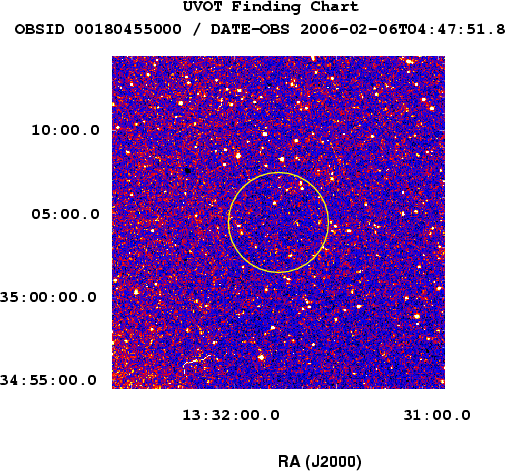
- GCN NOTICE
TITLE: GCN/SWIFT NOTICE
NOTICE_DATE: Mon 06 Feb 06 04:52:33 UT
NOTICE_TYPE: Swift-UVOT Processed Image
TRIGGER_NUM: 180455, Seg_Num: 0
POINT_RA: 202.961d {+13h 31m 51s} (J2000)
POINT_DEC: +35.073d {+35d 04' 22"} (J2000)
ROLL: 88.145d
IMG_START_DATE: 13772 TJD; 37 DOY; 06/02/06
IMG_START_TIME: 17270.79 SOD {04:47:50.79} UT, 57.5 [sec] since BAT Trigger Time
FILTER: 3, V
EXPOSURE_ID: 160894071
X_OFFSET: 690 [pixels]
Y_OFFSET: 900 [pixels]
WIDTH: 160 [pixels]
HEIGHT: 160 [pixels]
X_GRB_POS: 850
Y_GRB_POS: 1060
BINNING_INDEX: 1
IM_URL: sw00180455000msuni0057.fits
SUN_POSTN: 319.71d {+21h 18m 49s} -15.66d {-15d 39' 44"}
SUN_DIST: 120.59 [deg] Sun_angle= 7.8 [hr] (West of Sun)
MOON_POSTN: 55.32d {+03h 41m 17s} +23.81d {+23d 48' 32"}
MOON_DIST: 113.67 [deg]
MOON_ILLUM: 60 [%]
GAL_COORDS: 78.02, 78.27 [deg] galactic lon,lat of the pointing direction
ECL_COORDS: 184.88, 40.86 [deg] ecliptic lon,lat of the pointing direction
COMMENTS: SWIFT-UVOT Processed Image.
COMMENTS: The GRB Position came from the Window Position in the Mode Command.
COMMENTS: The image has 2x2 binning (compression).
COMMENTS: If you have elected to receive attachments:
COMMENTS: The uvot_catalog_image.fits.gz file does not exist; skipping the attachment.
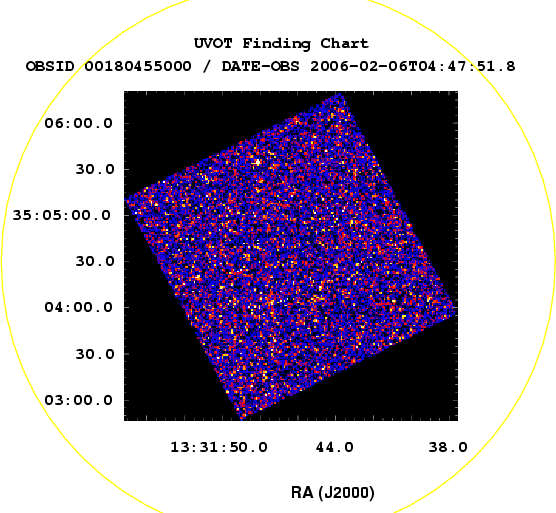
- GCN NOTICE
TITLE: GCN/SWIFT NOTICE
NOTICE_DATE: Mon 06 Feb 06 04:51:18 UT
NOTICE_TYPE: Swift-BAT GRB Lightcurve
TRIGGER_NUM: 180455, Seg_Num: 0
GRB_RA: 202.946d {+13h 31m 47s} (J2000),
203.015d {+13h 32m 04s} (current),
202.381d {+13h 29m 31s} (1950)
GRB_DEC: +35.075d {+35d 04' 29"} (J2000),
+35.043d {+35d 02' 36"} (current),
+35.332d {+35d 19' 53"} (1950)
GRB_DATE: 13772 TJD; 37 DOY; 06/02/06
GRB_TIME: 17213.27 SOD {04:46:53.27} UT
TRIGGER_INDEX: 124
GRB_PHI: 135.41 [deg]
GRB_THETA: 10.56 [deg]
DELTA_TIME: 12.00 [sec]
TRIGGER_DUR: 0.512 [sec]
LC_URL: sw00180455000msb.lc
SUN_POSTN: 319.70d {+21h 18m 49s} -15.66d {-15d 39' 45"}
SUN_DIST: 120.60 [deg] Sun_angle= 7.8 [hr] (West of Sun)
MOON_POSTN: 55.31d {+03h 41m 14s} +23.81d {+23d 48' 20"}
MOON_DIST: 113.67 [deg]
MOON_ILLUM: 60 [%]
GAL_COORDS: 78.07, 78.28 [deg] galactic lon,lat of the burst (or transient)
ECL_COORDS: 184.87, 40.85 [deg] ecliptic lon,lat of the burst (or transient)
COMMENTS: SWIFT-BAT GRB Lightcurve.
COMMENTS:
COMMENTS: The next comments were copied from the BAT_POS Notice:
COMMENTS: This is a rate trigger.
COMMENTS: A point_source was found.
COMMENTS: This does not match any source in the on-board catalog.
COMMENTS: This does not match any source in the ground catalog.
COMMENTS: This is a GRB.
COMMENTS: This trigger occurred at longitude,latitude = 306.25,4.41 [deg].
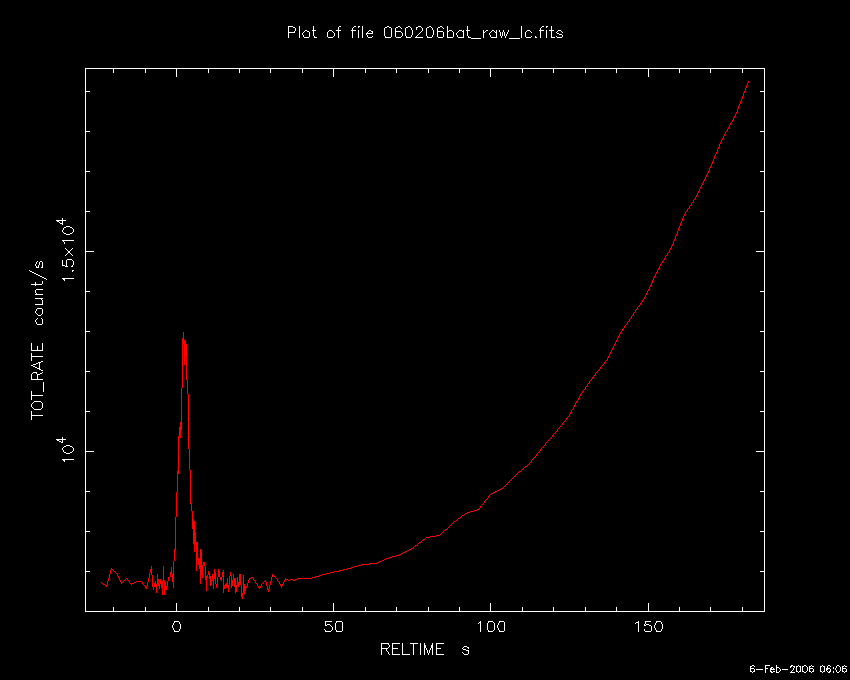
- GCN NOTICE
TITLE: GCN/SWIFT NOTICE
NOTICE_DATE: Mon 06 Feb 06 04:50:44 UT
NOTICE_TYPE: Swift-UVOT Image
TRIGGER_NUM: 180455, Seg_Num: 0
POINT_RA: 202.961d {+13h 31m 51s} (J2000)
POINT_DEC: +35.073d {+35d 04' 22"} (J2000)
ROLL: 88.145d
IMG_START_DATE: 13772 TJD; 37 DOY; 06/02/06
IMG_START_TIME: 17270.79 SOD {04:47:50.79} UT, 57.5 [sec] since BAT Trigger Time
FILTER: 3, V
EXPOSURE_ID: 160894071
X_OFFSET: 690 [pixels]
Y_OFFSET: 900 [pixels]
WIDTH: 160 [pixels]
HEIGHT: 160 [pixels]
X_GRB_POS: 850
Y_GRB_POS: 1060
BINNING_INDEX: 1
IM_URL: sw00180455000msuni0057.fits
SUN_POSTN: 319.70d {+21h 18m 49s} -15.66d {-15d 39' 45"}
SUN_DIST: 120.59 [deg] Sun_angle= 7.8 [hr] (West of Sun)
MOON_POSTN: 55.30d {+03h 41m 12s} +23.80d {+23d 48' 15"}
MOON_DIST: 113.68 [deg]
MOON_ILLUM: 60 [%]
GAL_COORDS: 78.02, 78.27 [deg] galactic lon,lat of the pointing direction
ECL_COORDS: 184.88, 40.86 [deg] ecliptic lon,lat of the pointing direction
COMMENTS: SWIFT-UVOT Image.
COMMENTS: The GRB Position came from the Window Position in the Mode Command.
COMMENTS: The image has 2x2 binning (compression).
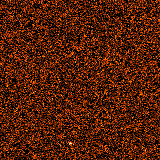
- GCN NOTICE
TITLE: GCN/SWIFT NOTICE
NOTICE_DATE: Mon 06 Feb 06 05:15:13 UT
NOTICE_TYPE: Swift-UVOT Source List
TRIGGER_NUM: 180455, Seg_Num: 0
POINT_RA: 202.964d {+13h 31m 51s} (J2000)
POINT_DEC: +35.071d {+35d 04' 16"} (J2000)
POINT_ROLL: 88.146d
IMG_START_DATE: 13772 TJD; 37 DOY; 06/02/06
IMG_START_TIME: 18644.03 SOD {05:10:44.03} UT, 1430.8 [sec] since BAT Trigger Time
FILTER: 3, V
BKG_MEAN: 1.430
N_STARS: 7
X_OFFSET: 370 [pixels]
Y_OFFSET: 580 [pixels]
X_MAX: 1329 [pixels]
Y_MAX: 1539 [pixels]
DET_THRESH: 10
PHOTO_THRESH: 5
SL_URL: sw00180455000msufc1430.fits
SUN_POSTN: 319.72d {+21h 18m 53s} -15.66d {-15d 39' 26"}
SUN_DIST: 120.60 [deg] Sun_angle= 7.8 [hr] (West of Sun)
MOON_POSTN: 55.53d {+03h 42m 08s} +23.87d {+23d 51' 59"}
MOON_DIST: 113.53 [deg]
MOON_ILLUM: 60 [%]
GAL_COORDS: 78.01, 78.27 [deg] galactic lon,lat of the pointing direction
ECL_COORDS: 184.88, 40.86 [deg] ecliptic lon,lat of the pointing direction
COMMENTS: SWIFT-UVOT Source List.
- GCN NOTICE
TITLE: GCN/SWIFT NOTICE
NOTICE_DATE: Mon 06 Feb 06 05:16:08 UT
NOTICE_TYPE: Swift-UVOT Processed Source List
TRIGGER_NUM: 180455, Seg_Num: 0
POINT_RA: 202.964d {+13h 31m 51s} (J2000)
POINT_DEC: +35.071d {+35d 04' 16"} (J2000)
POINT_ROLL: 88.146d
IMG_START_DATE: 13772 TJD; 37 DOY; 06/02/06
IMG_START_TIME: 18644.03 SOD {05:10:44.03} UT, 1430.8 [sec] since BAT Trigger Time
FILTER: 3, V
BKG_MEAN: 1.430
N_STARS: 7
X_OFFSET: 370 [pixels]
Y_OFFSET: 580 [pixels]
X_MAX: 1329 [pixels]
Y_MAX: 1539 [pixels]
DET_THRESH: 10
PHOTO_THRESH: 5
SL_URL: sw00180455000msufc1430.fits
SUN_POSTN: 319.72d {+21h 18m 53s} -15.66d {-15d 39' 26"}
SUN_DIST: 120.60 [deg] Sun_angle= 7.8 [hr] (West of Sun)
MOON_POSTN: 55.54d {+03h 42m 10s} +23.87d {+23d 52' 07"}
MOON_DIST: 113.52 [deg]
MOON_ILLUM: 60 [%]
GAL_COORDS: 78.01, 78.27 [deg] galactic lon,lat of the pointing direction
ECL_COORDS: 184.88, 40.86 [deg] ecliptic lon,lat of the pointing direction
COMMENTS: SWIFT-UVOT Processed Source List.
COMMENTS: All 4 attachments are included.
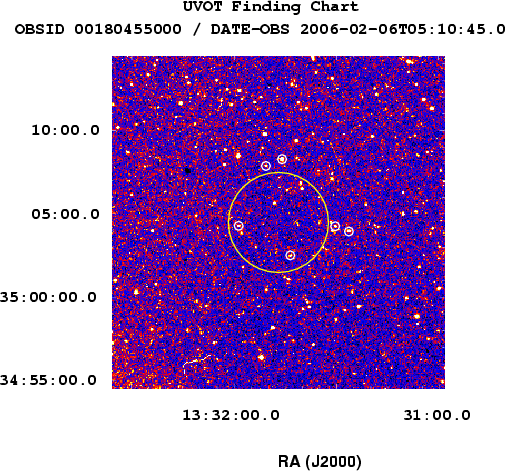
- GCN NOTICE
TITLE: GCN/SWIFT NOTICE
NOTICE_DATE: Mon 06 Feb 06 05:17:20 UT
NOTICE_TYPE: Swift-UVOT Image
TRIGGER_NUM: 180455, Seg_Num: 0
POINT_RA: 202.964d {+13h 31m 51s} (J2000)
POINT_DEC: +35.071d {+35d 04' 16"} (J2000)
ROLL: 88.146d
IMG_START_DATE: 13772 TJD; 37 DOY; 06/02/06
IMG_START_TIME: 18644.03 SOD {05:10:44.03} UT, 1430.8 [sec] since BAT Trigger Time
FILTER: 3, V
EXPOSURE_ID: 160895445
X_OFFSET: 690 [pixels]
Y_OFFSET: 900 [pixels]
WIDTH: 160 [pixels]
HEIGHT: 160 [pixels]
X_GRB_POS: 850
Y_GRB_POS: 1060
BINNING_INDEX: 1
IM_URL: sw00180455000msuni1430.fits
SUN_POSTN: 319.72d {+21h 18m 53s} -15.66d {-15d 39' 25"}
SUN_DIST: 120.60 [deg] Sun_angle= 7.8 [hr] (West of Sun)
MOON_POSTN: 55.55d {+03h 42m 13s} +23.87d {+23d 52' 18"}
MOON_DIST: 113.51 [deg]
MOON_ILLUM: 60 [%]
GAL_COORDS: 78.01, 78.27 [deg] galactic lon,lat of the pointing direction
ECL_COORDS: 184.88, 40.86 [deg] ecliptic lon,lat of the pointing direction
COMMENTS: SWIFT-UVOT Image.
COMMENTS: The GRB Position came from the Window Position in the Mode Command.
COMMENTS: The image has 2x2 binning (compression).
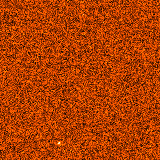
- GCN NOTICE
TITLE: GCN/SWIFT NOTICE
NOTICE_DATE: Mon 06 Feb 06 05:18:20 UT
NOTICE_TYPE: Swift-UVOT Processed Image
TRIGGER_NUM: 180455, Seg_Num: 0
POINT_RA: 202.964d {+13h 31m 51s} (J2000)
POINT_DEC: +35.071d {+35d 04' 16"} (J2000)
ROLL: 88.146d
IMG_START_DATE: 13772 TJD; 37 DOY; 06/02/06
IMG_START_TIME: 18644.03 SOD {05:10:44.03} UT, 1430.8 [sec] since BAT Trigger Time
FILTER: 3, V
EXPOSURE_ID: 160895445
X_OFFSET: 690 [pixels]
Y_OFFSET: 900 [pixels]
WIDTH: 160 [pixels]
HEIGHT: 160 [pixels]
X_GRB_POS: 850
Y_GRB_POS: 1060
BINNING_INDEX: 1
IM_URL: sw00180455000msuni1430.fits
SUN_POSTN: 319.72d {+21h 18m 54s} -15.66d {-15d 39' 24"}
SUN_DIST: 120.60 [deg] Sun_angle= 7.8 [hr] (West of Sun)
MOON_POSTN: 55.56d {+03h 42m 15s} +23.87d {+23d 52' 27"}
MOON_DIST: 113.51 [deg]
MOON_ILLUM: 60 [%]
GAL_COORDS: 78.01, 78.27 [deg] galactic lon,lat of the pointing direction
ECL_COORDS: 184.88, 40.86 [deg] ecliptic lon,lat of the pointing direction
COMMENTS: SWIFT-UVOT Processed Image.
COMMENTS: The GRB Position came from the Window Position in the Mode Command.
COMMENTS: The image has 2x2 binning (compression).
COMMENTS: If you have elected to receive attachments:
COMMENTS: The uvot_catalog_image.fits.gz file does not exist; skipping the attachment.
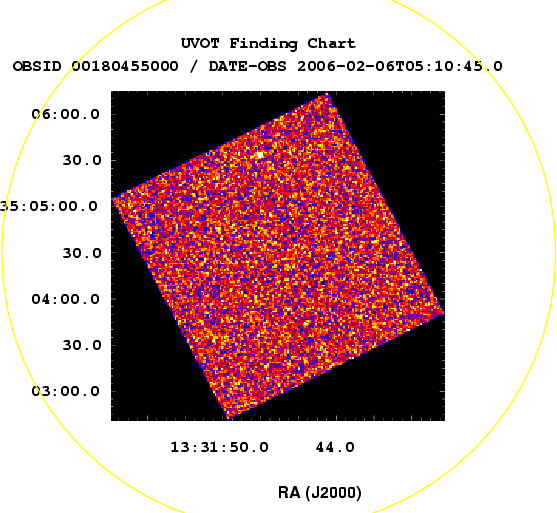
- GCN Circular #4682
D. Morris (PSU), L. Barbier (GSFC), S. Barthelmy (GSFC),
J. Cummings (GSFC/ORAU), N. Gehrels (GSFC), S. Hunsberger (PSU),
C. Markwardt (GSFC/UMd), D. Palmer (LANL), and E. Rol (U. Leicester)
on behalf of the Swift team:
At 04:46:53 UT, Swift-BAT triggered and located GRB060206
(trigger=180455).
The spacecraft slewed immediately. The BAT on-board location is
RA,Dec 202.946d,+35.075d {13h 31m 47s,+35d 04' 29"} (J2000), with
an uncertainty of 3 arcmin (radius, 90% containment, stat+sys).
The BAT light curve showed a single bright gaussian-peak
structure from T-1 to T+10 sec. The peak count rate was ~6000
counts/sec (15-350 keV), at ~2 seconds after the trigger.
The XRT began taking data at 04:47:52, 58 seconds after the BAT trigger.
The XRT on-board centroid algorithm did not find a source in the image
and no prompt position is available. The burst occurred shortly before
entry into the SAA, and therefore the count-rate lightcurve may be
insensitive to a fading source. We are waiting for down-linked data
to determine a position.
UVOT took a finding chart exposure of 72 seconds with the V filter
starting 58 seconds after the BAT trigger. No afterglow candidate has
been found in the initial data products. The 2.7'x2.7' sub-image
covers 25% of the BAT error circle. The 8'x8' region for the list
of sources generated on-board covers 100% of the BAT error circle.
No correction has been made forthe expected extinction of
about 0.04 magnitudes.
- GCN Circular #4683
Johan P. U. Fynbo, Brian L. Jensen, Jos=E9 Mar=EDa Castro Cer=F3n
(DARK Cosmology Centre), Jyri Naeraenen (Helsinki Observatory) report
on behalf of a larger collaboration:
"Using ALFOSC on the Nordic Optical Telescope we have identified
the likely afterglow of GRB060206 (GCN #4682) to the position:
RA(2000), Dec(2000) = 13:31:43.4, +35:02:59.9 (+/-5 arcsec)
Further observations are in progress"
- GCN Circular #4684
P. Boyd (GSFC), S. Hunsberger (PSU), and C. Gronwall (PSU)
on behalf of the Swift UVOT team:
The list of sources from the first 72-second V UVOT finding chart
exposure contains a bright, uncataloged optical source coincident
with the position reported by Fynbo et al (GCN 4683).
The UVOT source position is
RA(2000) 202.9309
Dec(2000) 35.0510
The mean positional error between known sources in the field and catalog
entries is 0.47".
The V magnitude is estimated to be approximately 16.7. No correction
has been made for the expected extinction of about 0.04 magnitudes.
- GCN Circular #4686
Johan P. U. Fynbo, Brian L. Jensen, Jos=E9 Mar=EDa Castro Cer=F3n
(DARK Cosmology Centre), Jyri Naeraenen (Helsinki Observatory) report
on behalf of a larger collaboration:
"Using ALFOSC on the Nordic Optical Telescope we have obtained
a spectrum of the afterglow of GRB 060206 (GCN #4682, 4683, #4684).
The spectrum shows a rich Lyman-alpha forest as well as metal lines
from the GRB host/environment. We still do not have a formal
wavelength calibration, but a preliminary analysis indicates
a redshift close to 5."
- GCN Circular #4687
P.R. Wozniak, W.T. Vestrand, J. Wren, R. White, and S. Evans
at Los Alamos National Laboratory on behalf of the RAPTOR team report:
RAPTOR's autonomous system for locating optical counterparts to GRBs
identified a variable object at position RA=202.931, DEC=35.0509 deg.
At 2900 seconds after the trigger RAPTOR measured an R-band magnitude
of ~17.3, followed by a brightening to ~16.3 mag over the next 700 seconds,
where it remained for about 200 seconds before fading to ~16.9 mag
over the next 45 min. The real time position was reported only to the RAPTOR
rapid response team because of unusual photometric behavior of the object.
This variable source has a location consistent with the position of the
optical afterglow candidate found by Fynbo et al. (GCN 4683) and confirmed
by Boyd et al. (GCN 4684).
- GCN Circular #4688
A.L. Homewood, K.V. Garimella, D.H. Hartmann (Clemson University), R.
Kaitchuck (BSU), and J.S. Shaw (UGA), report on behalf of the Clemson GRB
Follow-Up Team:
We began observations of the error box reported by Morris, et al (GCN
4682), beginning approximately 2.5 hours after the burst trigger. We
confirm the afterglow reported by Fynbo, et al (GCN 4683). We derive a
magnitude of R=17.77 +/- 0.26 mag after co-adding 10 300-second exposures
and calibrating relative to the USNO A2.0 catalog. The image may be found
at
http://people.clemson.edu/~kgarime/burst/detections/grb060206/
No extinction corrections have been made. Observations are continuing.
The Clemson Unversity GRB Response Site may be found at:
http://people.clemson.edu/~kgarime/burst/index.php
The SARA Homepage may be found at:
http://www.saraobservatory.org
This message may be cited.
- GCN Circular #4689
D. Morris (PSU), D. Burrows (PSU), N. Gehrels (GSFC), P. Boyd
(GSFC-UMBC), L. Angelini (GSFC-JHU) report on behalf of the Swift XRT
team:
We have analyzed the Swift XRT data from the first orbit observation of
GRB 060206 (Morris et al., GCN4682), with a total exposure of 337
seconds. We find an uncataloged, fading source at:
RA(J2000) = 13h 31m 43.4s
Dec(J2000) = +35d 03' 02.0"
This position is 99.0 arcseconds from the BAT position given in GCN 4682
and 1.8 arcseconds from the optical afterglow position reported in GCN
4683 (Fynbo et al) and refined in GCN 4684 (Boyd et al). We estimate an
uncertainty of 4 arcseconds radius (90% containment).
This circular is an official product of the Swift XRT Team.
- GCN Circular #4690
W. Li, University of California, Berkeley, on behalf of the
KAIT GRB team, report:
We began observations of the error box of GRB 060206 reported
by Morris et al. (GCN 4682) with the robotic 0.76-m Katzman
Automatic Imaging Telescope (KAIT) at Lick Observatory at about
3.9 hours after the burst, and the afterglow reported by Fynbo
et al. (GCN 4683) was clearly detected in all the images. The
afterglow is at magnitude 17.95 +/- 0.05 (calibrated to USNO
B1.0) in a 120s unfiltered image started at 08:41:52 UT (3.92
hours after the burst). A finder chart of the afterglow can
be found at http://astron.berkeley.edu/~weidong/grb060206.gif
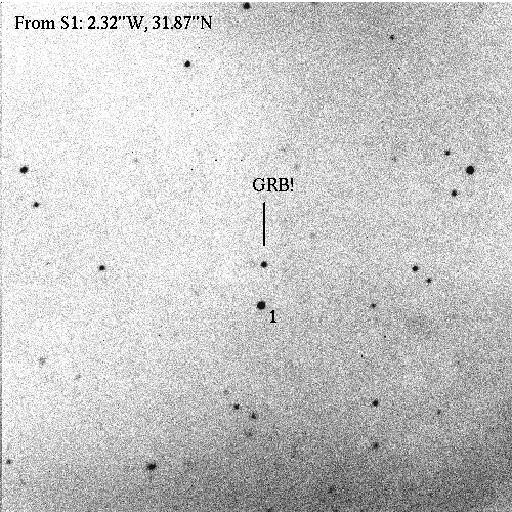
- GCN Circular #4691
E. O. Ofek, S. B. Cenko, A. M. Soderberg (Caltech), and D. B. Fox (Penn
State) report on behalf of a larger collaboration:
We have imaged the error circle of GRB060206A (Morris et al. GCN 4682),
with the automated Palomar 60-inch telescope, starting 1.4 hours after the
GRB trigger. Observations were taken under poor external conditions
(cirrus clouds and below-average seeing).
We find the afterglow reported by Fynbo et al. (GCN 4683) at J2000.0
coordinates:
RA: 13:31:43.47
Dec: +35:03:03.3
The R-band magnitude of the afterglow, ~3.44 hours after the GRB trigger
was about 17.2, assuming R=16.17 for the nearby USNO-B1 star 1250-0209088
(13:31:43.65 +35:02:31.4).
A finding chart can be found at:
http://astro.caltech.edu/~eran/GRB/060206/GRB060206_FC.jpg
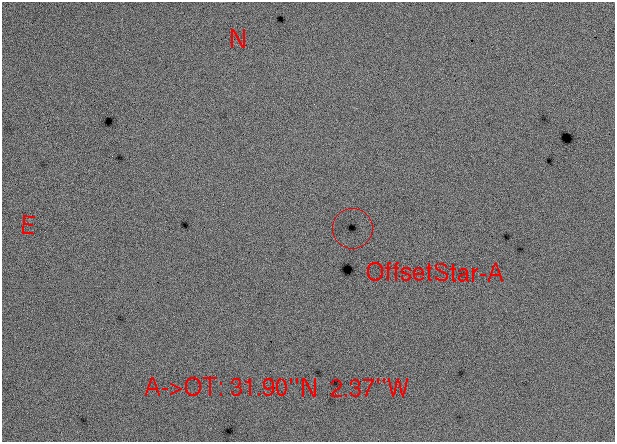
- GCN Circular #4692
Johan P. U. Fynbo, Marceau Limousin, Jos=E9 Mar=EDa Castro Cer=F3n,
Brian L. Jensen (DARK Cosmology Centre), Jyri N=E4r=E4nen (Helsinki
Observatory) report on behalf of a larger collaboration:
"From the calibrated ALFOSC spectrum of the afterglow of GRB 060206
(GCN #4682, #4683, #4684, #4686) we measure a redshift of
z=4.045 based on Lyman-alpha, SiII, SiII*, OI, CII and SiIV
among other lines. Our previous estimate was off due to a
calculation error for which we apologise."
- GCN Circular #4693
C. Guidorzi, A. Monfardini, A. Gomboc, C.G. Mundell, A. Melandri,
C.J. Mottram, R.J. Smith, I.A. Steele, D. Carter, M. Burgdorf,
S. Kobayashi, D. Bersier, M.F. Bode (Liverpool JMU) report:
"The 2-m Liverpool Telescope followed up the GRB060206 (Morris et
al, GCN 4682) and started observing its position at 5.23 min after the
GRB. We detect the optical afterglow in agreement with the candidate
from Fynbo et al. (GCN 4683) and Boyd et al. (GCN 4684).
The magnitude of the afterglow was R~16.5 (USNO-B1 calibrated) at ~5.2
min after the burst. After an initial fading, we confirm the
rebrightening (Wozniak et al., GCN 4687) with R~16.3 at 60 min
after the burst trigger time."
- GCN Circular #4694
D. Morris (PSU), D. Burrows (PSU), N. Gehrels (GSFC), J. Greiner (MPE),
D. Hinshaw (GSFC-SPSYS) report on behalf of the Swift XRT team:
We have analyzed the Swift XRT data from the first orbit of GRB 060206
(Morris et al., GCN4682), with a total exposure of 337 seconds. The
refined XRT position is:
RA(J2000) = 13h 31m 43.4s
Dec(J2000) = +35d 03' 02"
This position is 99.0 arcseconds from the BAT position given in GCN 4682
and 1.8 arcseconds from the optical afterglow position reported in GCN
4683 (Fynbo et al) and refined in GCN 4684 (Boyd et al). We estimate an
uncertainty of 4 arcseconds radius (90% containment).
The 0.2-10 keV light curve starts 65 seconds from the BAT trigger (T0).
Due to the the spacecraft entry into the SAA, only a very small amount
of data was collected during the first orbit. The available data suggest
a decaying lightcurve but are too sparse to determine an accurate
measure of the decay slope.
A preliminary spectral fit to the PC data gives a spectral power law
photon index of 2.0 =B1 0.3 in the 0.2-10 keV band with NH of 4e20
+4e20/-3e20. The galactic NH value for this direction is 1e20. The
unabsorbed 0.2-10 keV flux at the start of the XRT observation is
estimated to be about 8E-11 erg/cm2/s. Due to the uncertain nature of
the decay slope, we are currently unable to predict the expected flux at
T+24hrs.
Observations are ongoing and we will distribute further analysis as
data become available.
This circular is an official product of the Swift XRT Team.
- GCN Circular #4695
Richard J. Cool (Arizona), Daniel J. Eisenstein (Arizona), David
W. Hogg (NYU), Michael R. Blanton (NYU), David J. Schlegel
(LBNL), J. Brinkmann (APO), Donald P. Schneider (PSU), and
Daniel E. Vanden Berk (PSU) report:
The Sloan Digital Sky Survey (SDSS) imaged the field of burst
GRB060206 prior to the burst. As these data should be useful
as a pre-burst comparison and for calibrating photometry,
we are supplying the images and photometry measurements for
this GRB field to the community.
Data from the SDSS, including 5 FITS images, 3 JPGS, and
3 files of photometry and astrometry, are being placed at
http://mizar.as.arizona.edu/~grb/public/GRB060206
We supply FITS images in each of the 5 SDSS bands of a 8'x8'
region centered on the GRB position (ra=202.946 (13:31:47.0),
dec=35.0750 (35:04:30.0); GCN 4682), as well as 3 gri
color-composite JPGs (with different stretches). The units
in the FITS images are nanomaggies per pixel. A pixel is
0.396 arcsec on a side. A nanomaggie is a flux-density unit
equal to 10^-9 of a magnitude 0 source or, to the extent that
SDSS is an AB system, 3.631e-6 Jy. The FITS images have WCS
astrometric information.
In the file GRB060206_sdss.calstar.dat, we report photometry
and astrometry of 346 bright stars (r<20.5) within 15' of the
burst location. The magnitudes presented in this file are asinh
magnitudes as are standard in the SDSS (Lupton 1999, AJ, 118,
1406). Beware that some of these stars are not well-detected
in the u-band; use the errors and object flags to monitor
data quality.
In the files GRB060206_sdss.objects_flux.dat and
GRB060206_sdss.objects_magnitudes.dat, we report photometry
of 771 objects detected within 6' of the GRB position.
We have removed saturated objects and objects with model
magnitudes fainter than 23.0 in the r-band. The fluxes listed
in GRB060206_sdss.objects_flux.dat are in nanomaggies while
the magnitudes listed in GRB060206_sdss.objects_magnitudes.dat
are asinh magnitudes.
All quantities reported are standard SDSS photometry, meaning
that they are very close to AB zeropoints and magnitudes are
quoted in asinh magnitudes. Photometric zeropoints are known
to about 2% rms. None of the photometry is corrected for
dust extinction. The Schlegel, Finkbeiner, and Davis (1998)
predictions for this region are A_U=0.054 mag, A_g=0.040 mag,
A_r = 0.029 mag, A_i=0.022 mag, and A_z=0.015 mag.
There are currently no objects within 6 arcminutes of the GRB
position in the SDSS spectroscopic database.
SDSS astrometry is generally better than 0.1 arcsecond per
coordinate. Users requiring high precision astrometry should
take note that the SDSS astrometric system can differ from
other systems such as those used in other notices; we have
not checked the offsets in this region.
More detailed information pertaining to our SDSS GRB releases
can be found in our initial data release paper (Cool et
al. 2006, astro-ph/0601218). See the SDSS DR4 documentation
for more details: http://www.sdss.org/dr4.
These data have been reduced using a slightly different
pipeline than that used for SDSS public data releases.
We cannot guarantee that the values here will exactly match
those in the data release in which these data are included.
In particular, we expect the photometric calibrations to differ
by of order 0.01 mag.
This note may be cited, but please also cite the SDSS data
release paper, Adelman-McCarthy et al. (2006, ApJS, in press,
astro-ph/0507711), when using the data or referring to the
technical documentation.
- GCN Circular #4696
C.S. Lin, H.C. Lin, C.W. Chen, K.Y Huang W.H. Ip (NCU)
Y. Urata (RIKEN), Y. Qiu (NAOC) on behalf of EAFON report:
"We are observing GRB 060206 optical afterglow using 0.4-m and 1.0-m
telescope at Lulin observatory, Taiwan. The imaging observation with
B, V, R and I band were started at 15:49:15 UT (11.04 hours after the
burst). The optical afterglow is detected in all bands.
The stacked B-band image made from three 300 s exposures is available at
http://cosmic.riken.go.jp/grb/eafon/GRB060206_Lulin-B.jpg
MID Time(UT) Filter Exp. mag Telescope
-----------------------------------------
15.86 R 300s 18.8 LOT
Further observations and analysis are in progress"
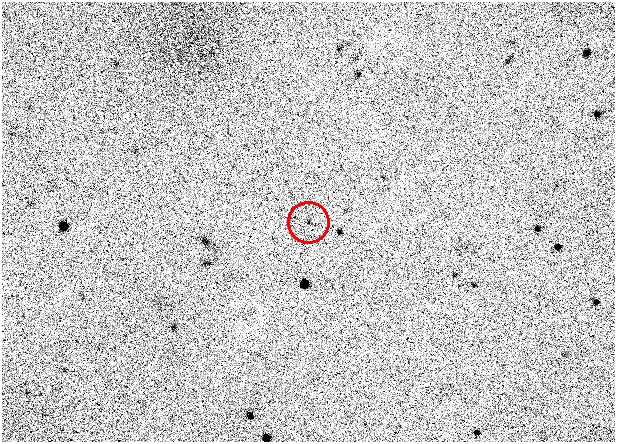
- GCN Circular #4697
D. Palmer (LANL), L. Barbier (GSFC), S. Barthelmy (GSFC),
M. Chester (PSU), J. Cummings (GSFC/ORAU), E. Fenimore (LANL),
N. Gehrels (GSFC), D. Hullinger (UMD), H. Krimm (GSFC/USRA),
C. Markwardt (GSFC/UMD), F. Marshall (GSFC), T. Mitani (ISAS),
A. Parsons (GSFC), T. Sakamoto (GSFC/ORAU), G. Sato (ISAS),
M. Suzuki (Saitama), J. Tueller (GSFC), on behalf of the Swift/BAT team:
Using the data set from T-60 to T+123 sec from the recent telemetry
downlink, we report further analysis of BAT GRB 060206 (trigger
# 180455) (GCN Circ 4682, Morris et al.). The BAT ground-calculated
position is (RA,Dec) = 202.932, 35.050 deg {13h 31m 43.8s, 35d 2' 58.7"}
(J2000) +- 1.0 arcmin, (radius, sys_stat, 90% containment). The partial
coding was 98%.
The 1-second binned light curve shows a single peak which extends out to
around 8 seconds in the two lowest energy bins (15-25 and
25-50 keV), but is shorter in duration in the two highest energy bins
(50-100 and 100-350 keV), extending out to only about 4 seconds. This
could be an indication the burst is softening with time. The highest
energy bin shows a possible double peak structure, with the first peak
at T0-1 second. T90 (15-350 keV) is 7 +- 2 seconds (estimated error
including systematics).
The time-averaged spectrum from T-0.6 to T+13.7 is best fit by a
power law with an exponential cutoff. This fit gives a photon index
1.06 +- 0.34, and Epeak of 75.4 +- 19.5 keV (chi squared 57.88
for 56 d.o.f.). For this model the total fluence in the 15 - 150 keV
band is (8.4 +- 0.4) x 10^-07 erg/cm2 and the 1-sec peak flux
measured form T+2.11 sec in the 15-150 keV band is (2.8 +- 0.2)
ph/cm2/sec. A fit to a simple power law gives a photon index
of 1.69 +- 0.08 (chi squared 69.94 for 57 d.o.f.).
All the quoted errors are at the 90% confidence level.
Using the best fit photon index and Epeak with a Band model with
the high energy photon index fixed at beta = -2.5, and the redshift
of 4.045 (Fynbo et al. GCN 4692), the isotropic-equivalent energy,
Eiso, integrated from 1 to 1000 keV at the GRB rest frame is
5.8 x 10^52 ergs. This Eiso and the Epeak at the GRB rest frame
((1+z)*Epeak = 380 keV) are consistent with the Epeak-Eiso (Amati)
relation (Amati et al, 2002). The Eiso in the BAT observed
energy band (76 - 757 keV in the GRB rest frame) is 3.1 x 10^52 ergs.
The estimated jet break time using the Eiso-Epeak-t_break relation
(Liang & Zhang, ApJ, 633, 611) would be 8.6 days after the burst
at the observer's frame (using the Band model). Using a cutoff
power-law for the analysis (which is also consistent with the
data) gives a 10.4 day estimate for the break time.
- GCN Circular #4699
P.A.Milne (Steward Obs), G.G. Williams (MMTO),
on behalf of the Super-LOTIS GRB team reports:
We observed the optical afterglow of GRB 060206 (GCN 4682, GCN 4683) using
the 60cm Super-LOTIS telescope at Kitt Peak, Arizona. Imaging began at
08:59:30 UT, 4.2 hours after the burst, and consisted of 20 one-minute
exposures in both the R and V filters. The optical counterpart was
detected at the following magnitudes:
UT Start UT End FILTER Magnitude
08:59:30 09:25:50 R 17.87 +/- 0.12
09:27:00 09:52:20 V 18.37 +/- 0.22
Magnitudes are based upon comparison with 9 & 5 stars, respectively,
from the Nomad-1 catalog, accessed through the USNO catalog service.
- GCN Circular #4701
J. X. Prochaska (UC Santa Cruz), D. S. Wong, S. H. Park,
A. V. Filippenko, R. J. Foley, and W. Li (UC Berkeley)
report:
"We observed the afterglow of GRB 060206 with the Kast
double spectrograph on the Shane 3-m reflector at Lick
Observatory for 6000 s starting at UT 10:11 on 6 Feb.,
under poor observing conditions. We confirm the report
from Fynbo et al. (GCN 4692) of strong metal-line features
and a damped Lya profile centered at z = 4.048 +/- 0.001.
The absence of a Lya forest redward of 6200 Ang marks this
absorption system as the ISM of the host galaxy of GRB 060206.
A Voigt profile analysis of the Lya profile gives
log N(HI) = 20.90 +/- 0.15. The absence of a strong feature at
SII 1253 places an upper limit to the metallicity of
[S/H] < -0.9, while the detection of Fe II 1608 implies
[Fe/H] > -1.7 dex. Finally, the rest EW of Si II 1526
(1.1 Ang) implies a velocity width for the low-ionization
species greater than 200 km/s.
This GCN may be cited.
- GCN Circular #4702
K. Alatalo, D. Perley and J. S. Bloom (UCB) report:
Starting at 2006-02-06 07:41:37 UT (2.91 hrs after the trigger) we began
observing the field of GRB060206 (GCN 4682) with PAIRITEL. The transient
reported by Fynbo et al. (GCN 4683, GCN 4689) is well detected in each
of the 1800s mosaics simultaneously in JHKs bands, and is seen to fade
between mosaics. The preliminary magnitude of the transient in the first
epoch of imaging in each band, calibrated to the 2MASS catalog, is:
J: 15.96 +- 0.03
H: 15.25 +- 0.03
Ks: 14.54 +- 0.04
This message may be cited.
- GCN Circular #4703
K. Aoki, T. Hattori (Subaru Telescope, NAOJ),
K. S. Kawabata (Hiroshima University), and N. Kawai (Tokyo Tech)
report on behalf of the Subaru GRB team:
"We have obtained the optical spectra of the afterglow of GRB060206
(Morris et al., GCN 4682) with FOCAS attached to the Subaru 8.2 m
Telescope on Mauna Kea.
We have taken the spectra covering wavelength regions of 5000-10000 A
at Feb 6.5 (UT) with a total exposure time of 4 hours. The spectral
resolutions were about R=500-1000. The optical spectra clearly show
rich absorption lines, with which we confirm the redshift of 4.05
(Fynbo et al. GCN 4692). We have detected C IV 1550, Fe II 1608, and
Al II 1670 in addition to Si II, Si II*, O I, C II, and Si IV reported
in GCN 4692. Besides the z=4.05 systems, we have found the z=2.26
and z=1.48 systems which show Mg II 2800 and Fe II absorption lines."
- GCN Circular #4706
D. Malesani (SISSA), H. Navasardyan (INAF/OApD), S. Piranomonte
(INAF/OAR), N. Masetti (INAF/IASF Bo), report on behalf of a larger
Italian collaboration:
We observed the afterglow of GRB 060206 (Morris et al., GCN 4682, 4689;
Fynbo et al., GCN 4683) with the AFOSC instrument at the Asiago
observatory (Northern Italy). The observing conditions were awful
(seeing of ~3.3"). Photometry was carried out in the R- and i- filters.
Despite the bad sky conditions, the object was well detected in both
filters (S/N~20). In particular, we find R = 19.65 +- 0.20 in comparison
with several USNO-B1 stars (R1 magnitude). The error is mostly due to
calibration. The mean time of the R-band observations (lasting 1 hr
overall) is 2005 Feb 7.0037 (0.80 d after the GRB).
This message may be cited.
- GCN Circular #4709
J. Haislip, A. LaCluyze, C. MacLeod, M. Nysewander, D. Reichart, J. A.
Crain, A. Foster, K. Ivarsen, and J. Kirshbrown report on behalf of the UNC
team of the FUN GRB collaboration:
We observed the localization of GRB 060206 (Morris et al., GCN 4682) with
two of the PROMPT telescopes in Ur'i' between 1.63 and 3.36 hours after the
burst under the automated control of Skynet.
The afterglow (Fynbo et al., GCN 4683) faded from r' = 16.85 +/- 0.05 mag
to r' = 17.83 +/- 0.12 mag over this period (calibrated to five SDSS stars;
Cool et al., GCN 4695.) The best-fit temporal index is -1.0.
PROMPT is currently being built and commissioned at CTIO.
- GCN Circular #4710
M. Nysewander, D. Reichart, A. Foster, M. Schwartz, P. Holvorcem report on
the behalf of the UNC team of the FUN GRB Collaboration:
We observed the localization of GRB 060206 (Morris et al., GCN 4682) with
the 32-inch Tenagra II telescope in the Arizona Sonoran Desert in the V
band beginning 26.5 hours after the burst.
We do not detect the afterglow (Fynbo et al., GCN 4683) to V > 19.2 mag (3
sigma) at an effective time of 27.3 hours after the burst (calibrated to
five NOMAD stars).
- GCN Circular #4712
J. Kirshbrown, C. MacLeod, A. LaCluyze, J. Haislip, M. Nysewander, D.
Reichart, J. A. Crain, A. Foster, and K. Ivarsen report on behalf of the
UNC team of the FUN GRB collaboration:
We continued to observe the localization of GRB 060206 (Morris et al., GCN
4682) with three of the PROMPT telescopes in Ui'I beginning 25.7 hours
after the burst under the automated control of Skynet.
We detect the afterglow (Fynbo et al., GCN 4683) at I = 18.79 +/- 0.16 mag
at an effective time of 26.3 hours after the burst (calibrated to five SDSS
stars; Cool et al., GCN 4695; using the transformation equations of Smith
et al. 2002.)
In the i' band, the afterglow continues to fade as a power law (Haislip et
al., GCN 4709), with a best-fit temporal index of -1.05 between 1.63 and
26.3 hours after the burst.
PROMPT is currently being built and commissioned at CTIO.
- GCN Circular #4713
M. Nysewander, J. Harvey, A. Foster, D. Reichart, J. A. Crain, K. Ivarsen,
and A. LaCluyze report on behalf of the UNC team of the FUN GRB
Collaboration:
We observed the localization of GRB 060206 (Morris et al., GCN 4682) with
the 14.5-inch Trubble Terrestrial Telescope (TTT) in the mountains west of
Fort Collins, Colorado, in red and green filters beginning 27.1 hours after
the burst under the automated control of Skynet:
Filter Start (UT) Stop (UT) Exposures Total (hr)
Red 07:54:35 08:50:41 14 x 160s 0.62
Green 09:20:34 11:12:58 35 x 160s 1.56
TTT is the first non-PROMPT telescope on Skynet. Between 27.1 and 28.5
hours after the burst, these observations were taken in synch with PROMPT
observations (Kirschbrown et al., GCN 4712).
We do not detect the afterglow (Fynbo et al., GCN 4683) to R > 18.5 mag (3
sigma) at an effective time of 27.6 hours after the burst (calibrated to 5
USNO-B1.0 stars).
- GCN Circular #4715
A.J. van der Horst (University of Amsterdam) reports on behalf of a larger
collaboration:
"We observed the position of the GRB 060206 afterglow at 4.9 GHz with the
Westerbork Synthesis Radio Telescope at February 7 21.89 UT to February 8
9.86 UT, i.e. 1.71 - 2.21 days after the burst (GCN 4682).
We do not detect a radio source within the SWIFT/XRT error circle (GCN
4689), in particular at the position of the optical counterpart (GCN 4683,
GCN 4684). The formal flux measurement for a point source at the position
of the optical counterpart is 39 +/- 22 microJy.
We note there is a bright radio source at RA 13h31m44.2s, Dec +35d03'04.6"
(+/- 0.5 arcsec, J2000), i.e. 12 arcsec offset from the optical/X-ray
counterpart position, with a flux of 738 +/- 28 microJy."
This message may be cited.
- GCN Circular #4716
H. Terada, T.-S. Pyo (Subaru Telescope, NAOJ), N. Kobayashi
(University of Tokyo) and N. Kawai (Tokyo Tech) report:
"Near-infrared photometry of the afterglow of GRB 060206
(Morris et al., GCN #4682) in the J, K'-bands was performed with IRCS
(Infrared Camera and Spectrograph) on the SUBARU Telescope at February
7.5 UT. An average seeing was 0.5 arcsec in the J-band and 0.3 arcsec
in the K'-band.
The magnitude of the afterglow was J=18.77 +/ -0.04 at 10:38-11:04 UT
(t=30.1 hr) and K'=17.78 +/ -0.01 at 13:37-14:30 UT (t=33.3 hr). The
near-infrared decay index of the afterglow is estimated to be -1.11 in
the J-band and -1.22 in the K'-band from comparison with the earlier
report (J=15.96 and Ks=14.54 at t=2.9 hr, GCN #4702)."
This message may be cited.
- GCN Circular #4722
P. Boyd (GSFC), D. Morris (PSU), F. Marshall (GSFC), N. Gehrels (GSFC)
on behalf of the Swift/UVOT team report:
The Swift/UVOT began observing the bright afterglow of GRB 060206 at
04:47:52 UT on 2006-02-06, approximately 57s after the BAT trigger (Morris
et al., GCN 4682). The afterglow is well detected in the individual B and
V exposures during the initial observation. The afterglow re-brightens in
both filters between 2000 to 5000-s after the BAT trigger. After this
event, the flux decays in both filters with a slope of ~1.15.
Filter T_range(s) Exp(s) Average mag
V 57-36588 2618 18.8
B 1662-34946 2911 21.3
Reported times are in seconds since BAT trigger.
In a follow-up observation, beginning about 0.8 d after the BAT trigger,
the source is not detected in B nor V down to the following 3-sigma
magnitude upper limits:
Filter T_range(s) Exp(s) mag upper limit
V 69308-150688 5001 >21.7
B 69656-150353 4679 >22.6
The afterglow is not detected in any other UVOT filter down to the
following 3-sigma magnitude upper limits:
Filter T_range(s) Exp(s) mag
U 1637-23385 1161 >21.5
UVW1 1757-5619 256 >20.6
UVM2 1733-30466 514 >21.3
UVW2 1686-35861 2638 >22.7
These magnitudes are uncorrected for Galactic extinction;
E(B-V) = 0.013.
- GCN Circular #4732
G. Greco (Bologna University), F. Terra, D. Nanni, (Second University
of Roma "Tor Vergata"), C. Bartolini, A. Guarnieri, A. Piccioni
(Bologna University), G. Pizzichini (INAF/IASF Bo) and R. Gualandi
(INAF Bologna) report:
During the night of February 6 -7, 2006 we observed the OT of
GRB 060206 (Morris et al. GCN 4682; Fynbo et al. GCN 4683) with
the 152 cm Loiano telescope equipped with the BFOSC camera system.
The weather conditions were not photometric and the seeing was
2.5 arcsec.
We obtained 3 images x 20 minutes in Rc filter, 2 x 30 minutes in V
and 2 x 20 minutes in I. The 2 V frames have been co-added.
We determined the following magnitudes derived from USNO-B1.0 (R1)
catalogue for the Rc and I bands and NOMAD catalogue for V band:
mean time (UT).......filter................ mag
6.960 ................ Rc ............ 19.78+/-0.15
6.976 ................ Rc ............ 19.70+/-0.11
6.990 ................ Rc ............ 19.79+/-0.12
7.025 ................ V ............. 20.06+/-0.17
7.054 ................ I ............. 19.16+/-0.11
7.069 ................ I ............. 19.19+/-0.10
We thank very much N. Masetti, who has obtained the images.
Our RVI images, in which the comparison stars are marked, have been
posted in our public directory from where they can be retrieved by
sftp using
hostname: ermione.bo.astro.it
username: publicGRB
password: GRB_bo.
- GCN Circular #4750
A. LaCluyze, M. Nysewander, J. Haislip, A. de Oliveira, D. Reichart, J.
Santos, A. Alvarez, S. Heathcote, J. C. Clemens, and A. Trotter report on
behalf of the UNC team of the FUN GRB collaboration:
We observed the localization of GRB 060206 (Morris et al., GCN 4682) with
4.1m SOAR at CTIO in VRI beginning 50.8 hours after the burst.
We detect the afterglow (Fynbo et al., GCN 4683) at I = 20.70 +/- 0.04 mag
at an effective time of 51.3 hours after the burst (calibrated to six SDSS
stars; Cool et al., GCN 4695; using the transformation equations of Smith
et al. 2002.)
A more careful analysis of PROMPT's I-band detection from the night before
(Kirschbrown et al., GCN 4712) yeilds I = 19.17 +/- 0.18 mag at an
effective time of 27.0 hours after the burst. This implies a temporal
index of -2.20 +/- 0.26 between 27.0 and 51.3 hours after the burst, which
is significantly steeper than the temporal index that we measured with
PROMPT on the first night (-1.0; Haislip et al., GCN 4709)
This suggests that the jet is breaking, and at a significantly earlier time
than estimated by Palmer et al. (GCN 4697).
Continued monitoring is encouraged.
- GCN Circular #4764
D. C. Morris (PSU), C. Pagani (PSU), D. N. Burrows (PSU), J. A. Kennea
(PSU) and K.Page (U. Leicester) report on behalf of the Swift XRT team:
The Swift XRT has continued to monitor the light curve of GRB060206 with
data taken as late as T+8 days. Our complete X-ray dataset from T+5ks to
T+700ks remains consistent with a single unbroken powerlaw decay with
alpha=1.35+/-0.15. We note that there is apparent variability, both
positive and negative, on the timescale of days in the X-ray lightcurve
somewhat larger than is implied by simple counting statistics. Our data
are not consistent, however, with a break to a slope of -2.2 at T+27
hours and thus we cannot confirm the presence of the jet break reported
in I-band observations by LaCluyze et al. (GCN 4750).
The XRT data remain consistent with the prediction by Palmer et al (GCN
4597) of a jet break at 8.6 or 10.4 days (743ks or 899ks). The XRT
countrate during the last observation, on February 14th, was 2e-3 cts/s,
equivalent to a flux of approximately 1.5e-13 ergs/cm2/s. Observations
are ongoing.
The XRT lightcurve can be viewed at
http://www.swift.psu.edu/images/GRB060206.jpg
This circular is an official product of the Swift XRT Team.
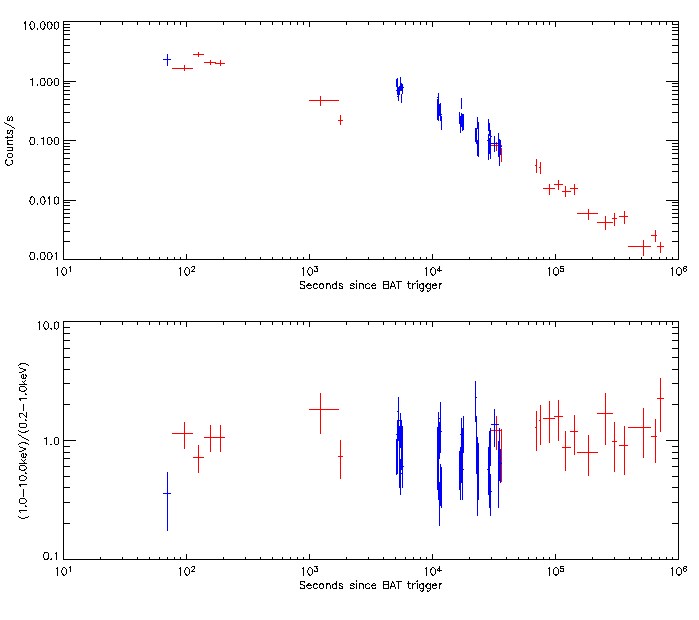
- GCN Circular #4768
D. Reichart, A. LaCluyze, M. Nysewander, and J. Haislip report on behalf of
the UNC team of the FUN GRB collaboration:
In addition to detecting the afterglow (Fynbo et al., GCN 4683) of GRB
060206 (Morris et al., GCN 4682) in I band 27.0 hours after the burst with
PROMPT (Kirschbrown et al., GCN 4712; LaCluyze et al., GCN 4750) and 51.3
hours after the burst with SOAR (LaCluyze et al., GCN 4750), we detected
the afterglow in i' band 26.0 hours after the burst with PROMPT, in V band
51.7 hours after the burst with SOAR, and in R band 51.9 hours after the
burst with SOAR.
At 26.0 hours after the burst, we measure i' = 19.83 +/- 0.22 mag.
From our V and R photometry and a simple model of the Ly-alpha forest, we
infer i' = 21.55 +/- 0.08 mag at 51.8 hours after the burst. (As a check,
simple interpolation between our R and I photometry yeilds i' = 21.36 +/-
0.05 mag at 51.6 hours after the burst.) This implies a temporal index of
-2.3 +/- 0.3 between 26.0 and 51.8 hours after the burst, which is
consistent with and independent of our measurement of -2.20 +/- 0.26
between 27.0 and 51.3 hours after the burst in I band (LaCluyze et al., GCN
4750).
PROMPT and SOAR light curves can be viewed at:
http://www.physics.unc.edu/~reichart/grb060206.eps
Continued monitoring is strongly encouraged, particularly given that no
break is observed in X rays (Morris et al., GCN 4764).
- astro-ph/0602403 from 17 Feb 2006
Wozniak: RAPTOR observations of delayed explosive activity in the high-redshift gamma-ray burst GRB 060206
The RAPid Telescopes for Optical Response (RAPTOR) system at Los Alamos
National Laboratory observed GRB 060206 starting 48.1 minutes after gamma-ray
emission triggered the Burst Alert Telescope (BAT) on-board the Swift
satellite. The afterglow light curve measured by RAPTOR shows a spectacular
re-brightening by ~1 mag about 1 h after the trigger and peaks at R ~ 16.4 mag.
Shortly after the onset of the explosive re-brightening the OT doubled its flux
on a time-scale of about 4 minutes. The total R-band fluence received from GRB
060206 during this episode is 2.3e-9 erg/cm2. In the rest frame of the burst (z
= 4.045) this yields an isotropic equivalent energy release of ~0.7e50 erg in
just a narrow UV band 130 +/- 22 nm. We discuss the implications of RAPTOR
observations for untriggered searches for fast optical transients and studies
of GRB environments at high redshift.
- astro-ph/0602444 from
20 Feb 2006
Fynbo:
We present early NOT/ALFOSC and WHT/ISIS optical spectroscopy of the
afterglow of the gamma-ray burst GRB060206. We measure a redshift of
z=4.0480+/-0.0002. Based on the measurement of the neutral hydrogen column
density from the damped Lyman-alpha line and the metal content from weak,
unsaturated SII lines we derive a metallicity of [S/H]=-0.84+/-0.10. This is
one of the highest metallicities measured from absorption lines at z~4. From
the very high column densities for the forbidden SiII*, OI*, and OI** lines we
infer very high densities in the system, significantly larger than 10^4 cm^-3.
There is also tentative evidence for the presence of H_2 molecules
corresponding to log N(H_2)~15.2 for both J=0 and J=1, translating to a
molecular fraction of log(f)~-5 with f=2N(H_2)/(2N(H_2)+N(HI)). We also discuss
how GRBs can help resolve the so-called missing metals problem. Although GRBs
may only be formed by massive stars with metallicities below ~0.25 Z_sun, we
argue that they will still be fairly unbiased tracers of star formation at
z>2.
Hence, metallicities derived as in this Letter for a complete sample of GRB
afterglows will directly show the distribution of metallicities for
star-forming galaxies at these redshifts. Moreover, the distribution of GRB
host galaxy luminosities will be crucial for the determination of the faint end
slope of the luminosity function which in turn is important for determining the
cosmic star-formation density.
- astro-ph/0602495 from
23 Feb 2006
Stanek:
We report on two recent z~4 gamma-ray bursts (GRBs), GRB 060206 and GRB
060210, for which we have obtained well-sampled optical light curves. Our data,
combined with early optical data reported in the literature, shows unusual
behavior for both afterglows. In R-band GRB 060206 (z=4.045) experienced a slow
early decay, followed by a rapid increase in brightness by factor ~2.5 about 1
hour after the burst. Its afterglow then faded in a broken power-law fashion,
with a smooth break at t_b=0.6 days, but with additional, less dramatic (~10%)
``bumps and wiggles'', well detected in the densely sampled light curve. The
R-band afterglow of GRB 060210 (z=3.91) is also unusual: the light curves was
more or less flat between 60 and 300 sec after the burst, followed by ~70%
increase at ~600 sec after the burst, after which the light curve declined as a
\~t^{-1.3} power-law. The early X-ray light curve of GRB 060210 exhibited two
sharp flares, but later X-ray emission fades in the same fashion as the optical
light curve. Despite earlier reports to the contrary, we find that for GRB
060206 X-rays also more or less follow the optical decay, but with significant
variations on short timescales. We argue that ``anomalous'' optical afterglows
are likely to be the norm, and that the rapid variations often seen in
Swift-XRT data would also be seen in the optical light curves, given good
enough sampling. As a result, some of the often employed procedures, such as
deriving the jet opening angle using a smooth broken power-law fit to the
optical light curves, in many cases might have a poor statistical significance.
We argue that the early increase in brighness for both bursts might be due to
the turn-on of the external shock. Existence of such features could provide
valuable additional information about the burst. (Abridged)
- astro-ph/0603181 from 8
Mar 2006
Monfardini:
The 2-m robotic Liverpool Telescope (LT) reacted promptly to the
high-redshift (z=4.048) gamma-ray burst GRB 060206. The afterglow was
identified automatically and multicolor r'i'z' imaging was triggered without
human intervention. Combining our data with those obtained from later
follow-ups provides a well-sampled optical light-curve from 5 minutes to >2d
after the gamma event. The light-curve is highly structured with at least three
bumps evident in the first 75 minutes, including a major rebrightening
(Delta_r'=-1.6 at t=3000s), interpreted as late energy injection. At early time
(t=440s), we find evidence for fast (Delta t_(rest)<4s<<t) variability,
indicating on-going internal-engine activity. We emphasise that a low redshift
GRB (z<1) with similar intrinsic properties would have been interpreted
completely differently due to undersampling of the light curve in the rest
frame at early times; the light-curve behaviour of GRB 060206 should therefore
not be considered peculiar. Finally, although the observed late-time steepening
of the optical light curve resembles a jet break if taken in isolation, the
lack of a corresponding change in the X-ray slope rules out a jet-break
interpretation. Traditionally, GRB jet breaks have been inferred from optical
data in the absence of simultaneous X-ray data. We suggest therefore that
current estimates of the jet opening angle distribution might be biased by
events like GRB060206. Consequently, the GRB explosion energy distribution and
event rates may have to be revised.
- GCN Circular #4901
D. Sharapov (MAO, and NOT, La Palma), M. Ibrahimov, (MAO), A. Pozanenko
(IKI) on behalf of larger GRB follow up collaboration report:
We observed the localization of GRB 060206 (Morris et al., GCN 4682) with
1.5m telescope of Maidanak Astronomical Observatory in R-band between (UT)
Feb. 07 23:26:38 and Feb. 08 00:36:06 (18x180 s) with a mean seeing 0.95".
We detect the afterglow (Fynbo et al., GCN 4683) at R=20.78 +/- 0.03 at
mean time (UT) Feb. 8.000. Calibration is based on SDSS stars; Cool et al.,
GCN 4695 using the transformation equations (Lupton, 2005). Combining this
value with a light curve presented by Stanek et al. (astro-ph/0602495) one
can suggest the jet brake later than 0.6 days. The value R=20.78 +/- 0.03 is
also correlated with possible XRT light curve rebrightening (XRT light
curve presented in the astro-ph/0602495). There is a tentative short time
scale rebrightening within our observation; more detailed calibration is
underway.
The stacked image can be found in
http://grb.rssi.ru/GRB060206/GRB060206_060207_AZT22_R.jpg
The message may be cited.
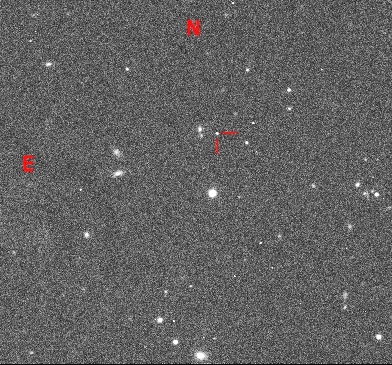
- astro-ph/0612409 from 15 Dec 2006
Hao: Strongly Variable z=1.48 MgII and FeII Absorption in the Spectra of z=4.05 GRB 060206
We report on the discovery of strongly variable MgII and FeII absorption
lines seen at z=1.48 in the spectra of the z=4.05 GRB 060206 obtained between
4.13 to 7.63 hours after the burst. In particular, the FeII line equivalent
width (EW) decayed rapidly from 1.72+-0.25 AA to 0.28+-0.21 AA, only to
increase to 0.96+-0.21 AA in a later date spectrum. The MgII doublet shows even
more complicated evolution: the weaker line of the doublet drops from
2.05+-0.25 AA to 0.92+-0.32 AA, but then more than doubles to 2.47+-0.41 AA in
later data. The ratio of the EWs for the MgII doublet is also variable, being
closer to 1:1 (saturated regime) when the lines are stronger and becoming
closer to 2:1 (unsaturated regime) when the lines are weaker, consistent with
expectations based on atomic physics. We have investigated and rejected the
possibility of any instrumental or atmospheric effects causing the observed
strong variations. The possibility of variable intervening absorption in GRB
spectra was recently predicted by Frank et al.
(astro-ph/0605676). Our
discovery of clearly variable intervening FeII and MgII lines lends very strong
support to their scenario, in which the characteristic size of intervening
patches of MgII ``clouds'' is comparable to the GRB beam size, i.e, about 10^16
cm. We discuss various implications of this discovery, including the nature of
the MgII absorbers, the physics of GRBs, and measurements of chemical
abundances from GRB and quasar absorption lines.
- 0706.1188from 8 Jun 2007
Curran: GRB 060206 and the quandary of achromatic breaks in afterglow light curves
Abstract: Gamma-ray burst afterglow observations in the Swift era have a perceived lack
of achromatic jet breaks compared to the BeppoSAX era. We examine the effect of
the fact that pre-Swift afterglow observations tend to be dominated by the
optical, whereas in the Swift era most well sampled light curves are in the
X-ray. We present our multi-wavelength analysis of GRB 060206 as an
illustrative example to demonstrate the possible effect of this change. The
results of temporal and spectral analyses are compared, and attempts are made
to fit the data within the context of the standard blast wave model. We find
that while the break appears more pronounced in the optical and evidence for it
from the X-ray alone is weak, the data are actually consistent with an
achromatic break at about 16 hours. This break and the light curves fit
standard blast wave models, either as a jet break or as an injection break. The
Swift and pre-Swift samples of afterglows could well be consistent in their
break behaviour, but the lack of accurate models for jet breaks and the dearth
of well sampled late time optical light curves for Swift bursts preclude
definitive statements on the matter.
- 0808.1172 from 8 Aug 2008
Liu: GRB 060206: hints of precession of the central engine?
Abstract: Aims. The high-redshift (z = 4:048) gamma-ray burst GRB 060206 showed unusual
behavior, with a significant rebrightening by a factor of ~ 4 at about 3000 s
after the burst. We argue that this rebrightening implies that the central
engine became active again after the main burst produced by the first ejecta,
then drove another more collimated jet-like ejecta with a larger viewing angle.
The two ejecta both interacted with the ambient medium, giving rise to forward
shocks that propagated into the ambient medium and reverse shocks that
penetrated into the ejecta. The total emission was a combination of the
emissions from the reverse- and forward- shocked regions. We discuss how this
combined emission accounts for the observed rebrightening. Methods. We apply
numerical models to calculate the light curves from the shocked regions, which
include a forward shock originating in the first ejecta and a forward-reverse
shock for the second ejecta. Results. We find evidence that the central engine
became active again 2000 s after the main burst. The combined emission produced
by interactions of these two ejecta with the ambient medium can describe the
properties of the afterglow of this burst. We argue that the rapid rise in
brightness at ~ 3000 s in the afterglow is due to the off-axis emission from
the second ejecta. The precession of the torus or accretion disk of the central
engine is a natural explanation for the departure of the second ejecta from the
line of sight.
- 0808.4157from 29 Aug 2008
Aoki: No Evidence for Variability of Intervening Absorption Lines toward GRB 060206: Implications for the Mg II Incidence Problem
Abstract: We examine variability of absorption line strength of intervening systems
along the line of sight to GRB 060206 at z=4.05, by the low-resolution optical
spectra obtained by the Subaru telescope from six to ten hours after the burst.
Although strong variabilities of Fe II and Mg II lines at z=1.48 during t=5-8
hours have been reported for this GRB (Hao et al. 2007), our spectra with
higher signal-to-noise ratio do not show any evidence for variability in t=6-10
hours. There is a clear discrepancy between our data and Hao et al. data in the
overlapping time interval. Furthermore, the line strengths in our data are in
good agreement with those observed at t~2 hours by Thone et al.(2008). We also
detected Fe II and Mg II absorption lines for a system at z=2.26, and these
lines do not show evidence for variability either. Therefore we conclude that
there is no evidence for variability of intervening absorption lines toward GRB
060206. The intervening line variability has been used to support the idea of
clumpy Mg II cloudlets that was originally proposed to explain the anomalously
high incidence of Mg II absorbers in GRB spectra compared with quasars, but
this Mg II incidence anomaly should be explained by other effects.
![]() Previous IAU Circulars
Previous IAU Circulars 











